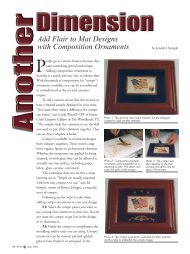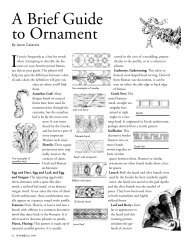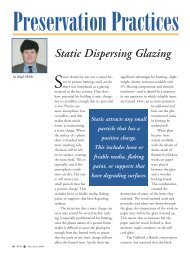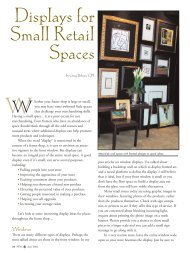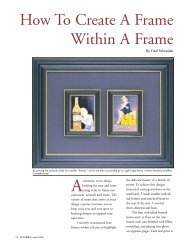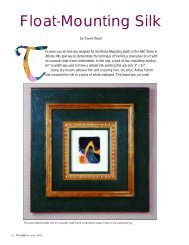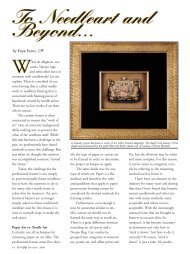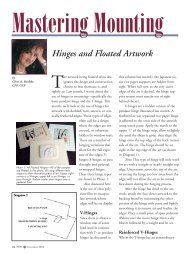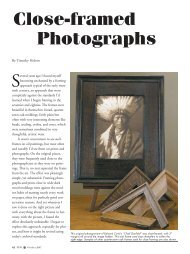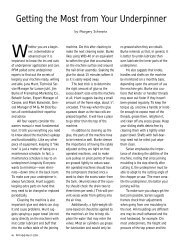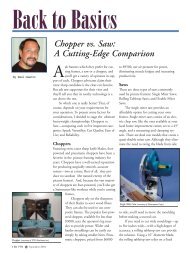TABLE OF CONTENTS - Picture Framing Magazine
TABLE OF CONTENTS - Picture Framing Magazine
TABLE OF CONTENTS - Picture Framing Magazine
You also want an ePaper? Increase the reach of your titles
YUMPU automatically turns print PDFs into web optimized ePapers that Google loves.
ideal archival glazing<br />
material would transmit,<br />
“The<br />
without distortion, all the<br />
light in the visible spectrum and would<br />
block ultraviolet radiation. It would<br />
resist impact and carry no static charge.<br />
Available in any size, this material<br />
would also be lightweight, rigid, and<br />
show no effects of aging. To satisfy other<br />
framing requirements, it would be non-<br />
reflective, abrasion resistant, and nei-<br />
ther expand nor contract with changes in<br />
temperature and humidity. Sad to say, no<br />
miraculous glazing material exhibits all<br />
of these qualities. At best, or options<br />
today satisfy only three or four of the<br />
dozen requirements listed above. Our<br />
task, then, is to sort out the best choice<br />
for each circumstance.<br />
In the paragraphs below I compare<br />
a number of attributes of glass and<br />
acrylic (polymethyl methacrylate) glaz-<br />
ing. I have omitted an discussion of<br />
polycarbonate, a virtually unbreakable<br />
sheet with UV shielding pro p e rt i e s ,<br />
because it is so rarely re q u i re d .<br />
Discussions of abrasion re s i s t a n c e ,<br />
expansion and contraction, and weight<br />
have also been ommitted.<br />
In choosing which glazing sheet<br />
to use, a number of questions must<br />
be considere d .<br />
1. Is the work susceptible to<br />
UV damage?<br />
36 PFM February 1996<br />
2. Under what lighting conditions is<br />
the work likely to be displayed?<br />
3. Is it likely that the work will<br />
be shipped?<br />
AGING:<br />
4. Is the media loose?<br />
5. How stiff is the paper support?<br />
The only aging process glass is subject<br />
to which may be of interest to framers is<br />
that, with time, microscopic surf a c e<br />
scratches may slightly reduce light<br />
transmission. Acrylic, like all organic<br />
materials, ages, but very slowly. Some<br />
tests have shown that it loses a small<br />
percentage of light transmission and yel-<br />
lows slightly over a number of years of<br />
heavy weathering. These losses are so<br />
modest that they are unlikely to be per-<br />
ceptible to the human eye. There is<br />
much concern among framers that the<br />
UV absorbing acrylic glazing may<br />
diminish with time, but so far studies<br />
have shown no loss of protection.<br />
EM I S S I O N S/ OU T G A S S I N G<br />
P i c t u re framing glass is not know to<br />
cause any problems by emission of<br />
gasses or liquids. Acrylic sheet, theo-<br />
re t i c a l l y, may emit small quantities of<br />
monomer after manufacture .<br />
Engineers at major U.S. manufactur-<br />
ers, however, have found their pro d-<br />
ucts emit very little, if any.<br />
Glazing A<br />
The following is an excerpt from the <strong>Picture</strong> <strong>Framing</strong> <strong>Magazine</strong> 1993<br />
P re s e rv a t i o n / C o n s e rvation <strong>Framing</strong> Supplement, authored by Jared Bark.<br />
DEFLECTION AND THICKNESS<br />
Glass is rigid, and in picture frames<br />
deflection is barely perceptible and<br />
unlikely to pose a risk to framed art.<br />
Acrylic sheet is flexible and subject to<br />
deflection, which distorts reflections.<br />
The major concern of framers is that<br />
acrylic glazing may bow in, touching a<br />
framed work of art. This likelihood is<br />
increased by lighting conditions; in tests<br />
we have performed, the interior of a<br />
frame lighted with incandescent exhibi-<br />
tion lights was found to be from 5 to 6<br />
degrees warmer than the outside air.<br />
This difference may be enough to cause<br />
the glazing to slightly inward. Over<br />
time, diff e rence in relative humidity<br />
inside and outside the frame or case may<br />
also cause deflection, with the acrylic<br />
bowing toward the more humid side.<br />
Because of the risk of acry l i c<br />
bowing into the frame, I do not re c o m-<br />
mend using sheets thinner than .118”<br />
(3 mm), although .098” material (2.5<br />
mm) is used by framers in small<br />
frames. We commonly use .118” sheet<br />
up to about 40”x40”. Above these<br />
dimensions, 3/16” sheet is pre f e r a b l e ,<br />
and 1/4” acrylic may be used on the<br />
l a rgest pieces.<br />
Since acrylic glazing is subject to<br />
horizontal deflection, it should never be<br />
shipped lying flat. Horizontal bowing<br />
of 1/8” acrylic, size 36”x36”, is 6/16”;



